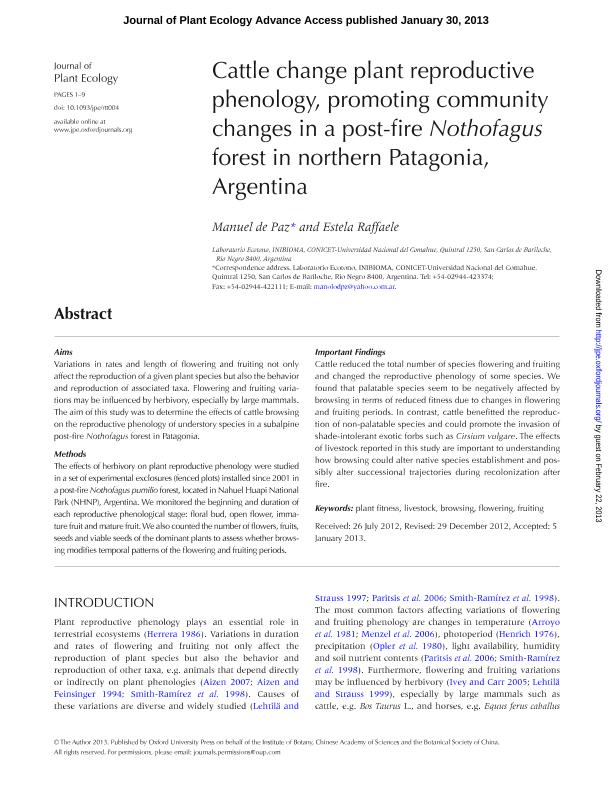Mostrar el registro sencillo del ítem
dc.contributor.author
de Paz, Manuel

dc.contributor.author
Raffaele, Estela

dc.date.available
2016-07-26T20:06:37Z
dc.date.issued
2013-02
dc.identifier.citation
de Paz, Manuel; Raffaele, Estela; Cattle change plant reproductive phenology, promoting community changes in a post-fire Nothofagus forest in northern Patagonia, Argentina; Oxford University Press; Journal Of Plant Ecology-uk; 6; 6; 2-2013; 459-467
dc.identifier.issn
1752-9921
dc.identifier.uri
http://hdl.handle.net/11336/6710
dc.description.abstract
Aims Variations in rates and length of flowering and fruiting not only affect the reproduction of a given plant species but also the behavior and reproduction of associated taxa. Flowering and fruiting variations may be influenced by herbivory, especially by large mammals. The aim of this study was to determine the effects of cattle browsing on the reproductive phenology of understory species in a subalpine post-fire Nothofagus forest in Patagonia.
Methods The effects of herbivory on plant reproductive phenology were studied in a set of experimental exclosures (fenced plots) installed since 2001 in a post-fire N. pumilio forest, located in Nahuel Huapi National Park (NHNP), Argentina. We monitored the beginning and duration of each reproductive phenological stage: floral bud, open flower, immature fruit and mature fruit. We also counted the number of flowers, fruits, seeds and viable seeds of the dominant plants to assess whether browsing modifies temporal patterns of the flowering and fruiting periods.
Important Findings Cattle reduced the total number of species flowering and fruiting and changed the reproductive phenology of some species. We found that palatable species seem to be negatively affected by browsing in terms of reduced fitness due to changes in flowering and fruiting periods. In contrast, cattle benefitted the reproduction of non-palatable species and could promote the invasion of shade-intolerant exotic forbs such as Cirsium vulgare. The effects of livestock reported in this study are important to understanding how browsing could alter native species establishment and possibly alter successional trajectories during recolonization after fire.
dc.format
application/pdf
dc.language.iso
eng
dc.publisher
Oxford University Press

dc.rights
info:eu-repo/semantics/openAccess
dc.rights.uri
https://creativecommons.org/licenses/by-nc-sa/2.5/ar/
dc.subject
Plant Fitness
dc.subject
Livestock
dc.subject
Flowering
dc.subject
Fruiting
dc.subject.classification
Ecología

dc.subject.classification
Ciencias Biológicas

dc.subject.classification
CIENCIAS NATURALES Y EXACTAS

dc.title
Cattle change plant reproductive phenology, promoting community changes in a post-fire Nothofagus forest in northern Patagonia, Argentina
dc.type
info:eu-repo/semantics/article
dc.type
info:ar-repo/semantics/artículo
dc.type
info:eu-repo/semantics/publishedVersion
dc.date.updated
2016-07-22T18:52:55Z
dc.journal.volume
6
dc.journal.number
6
dc.journal.pagination
459-467
dc.journal.pais
Reino Unido

dc.journal.ciudad
Oxford
dc.description.fil
Fil: de Paz, Manuel. Consejo Nacional de Investigaciones Científicas y Técnicas. Centro Científico Tecnológico Patagonia Norte. Instituto de Investigación En Biodiversidad y Medioambiente; Argentina
dc.description.fil
Fil: Raffaele, Estela. Consejo Nacional de Investigaciones Científicas y Técnicas. Centro Científico Tecnológico Patagonia Norte. Instituto de Investigación en Biodiversidad y Medioambiente; Argentina
dc.journal.title
Journal Of Plant Ecology-uk

dc.relation.alternativeid
info:eu-repo/semantics/altIdentifier/url/http://jpe.oxfordjournals.org/content/6/6/459
dc.relation.alternativeid
info:eu-repo/semantics/altIdentifier/doi/http://dx.doi.org/10.1093/jpe/rtt004
dc.relation.alternativeid
info:eu-repo/semantics/altIdentifier/doi/10.1093/jpe/rtt004
Archivos asociados
